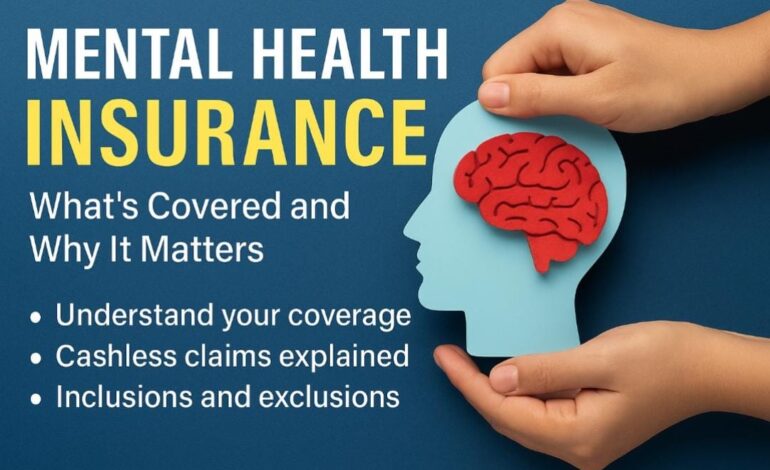
India’s Mental Health Insurance Gap: Are You Really Protected?
Mental Health Is Health—And Your Policy Should Reflect That
Mental Health Insurance : Mental health is finally getting the attention it deserves. And on the financial front, your health insurance policy should reflect that change too.
In India, the Mental Healthcare Act of 2017 ensures that mental illnesses are covered at par with physical ones. Yet, many policyholders are still unsure about what’s included, how cashless claims work, and how to choose the right cover. This guide breaks it all down—clearly, simply, and with your peace of mind in focus.
What Is Mental Health Insurance?
Mental health insurance refers to the part of your health plan that covers treatment for mental illnesses. This includes expenses related to:
- Hospitalisation
- Consultations
- Therapy sessions
- Medication
Coverage depends on your specific policy, but under Indian law, insurers must treat mental and physical ailments equally.
Why Mental Health Insurance Is Essential
Mental conditions like depression, anxiety, or bipolar disorder often need long-term, ongoing care. Without proper coverage, the treatment costs can be overwhelming.
Key Benefits:
- Reduces out-of-pocket treatment costs
- Encourages access to quality care
- Covers both in-patient and some out-patient expenses
- Supports financial stability during mental health crises
Common Conditions Covered
Most standard health plans now include coverage for:
- Depression
- Anxiety disorders
- Bipolar disorder
- Schizophrenia
- Post-Traumatic Stress Disorder (PTSD)
Note: Exact coverage may vary by insurer and severity of illness.
How Cashless Claims Work for Mental Health
Cashless health insurance allows you to receive treatment at a network hospital without paying upfront. The insurer directly settles the bill with the hospital.
Steps to Use Cashless Claims:
- Choose a hospital from the insurer’s network.
- Submit a pre-authorization request.
- Pay only for non-covered expenses (if any).
Inclusions in Mental Health Insurance
Policies generally cover:
- Hospitalisation for mental health issues
- Prescribed medication during hospital stay
- Doctor consultation and diagnostic tests
- Therapy costs (in some cases)
- Pre and post-hospitalisation for defined durations
What’s Not Covered?
Being aware of exclusions can save you from future shocks.
Common Exclusions:
- Counselling without hospitalisation
- Suicide attempts or self-inflicted harm
- Substance abuse treatments
- Unapproved or alternative therapies
Always read your policy’s fine print to avoid surprises.
Tips to Choose the Right Policy
- Read the fine print – Know the inclusions and exclusions.
- Check OPD coverage – Some policies now include out-patient consultations.
- Compare waiting periods – Some mental health covers have waiting clauses.
- Clarify with your insurer – Ask questions before you sign.
- Use digital platforms – Easier comparisons and lower costs.
How to File a Claim for Mental Health Treatment
For Cashless Claims:
- Visit a network hospital
- Submit pre-authorisation
- The insurer directly pays the bill
For Reimbursement:
- Pay first
- Submit hospital bills and prescriptions
- The insurer reimburses you
Final Thoughts
Mental health is just as important as physical health—and your policy should support that reality.
Investing in a plan that covers mental health gives you access to quality care without financial anxiety. Whether you opt for cashless or reimbursement options, understanding your coverage can offer clarity, comfort, and support in tough times.
Disclaimer: This article is for general awareness purposes only. Always consult with your insurer or read the policy document thoroughly before making a decision.
Also Read: From Transformers to Tech: These 3 Indian Energy Stocks Have Grown up to 7x






